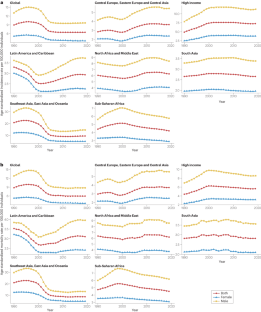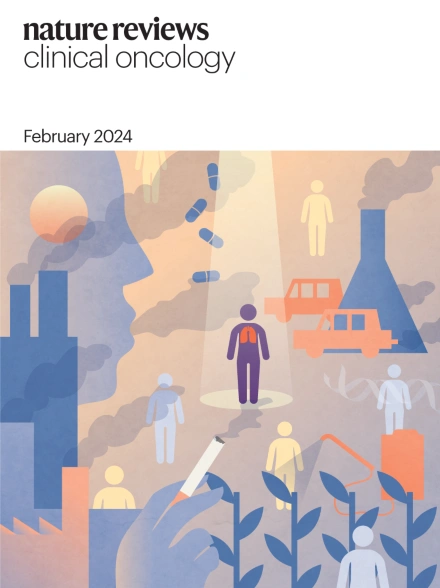肝细胞癌流行病学的全球趋势:对筛查、预防和治疗的启示。
IF 81.1
1区 医学
Q1 ONCOLOGY
引用次数: 0
摘要
肝细胞癌(HCC)死亡率在全球范围内不断上升,尤其是在西方国家。肝硬化仍是HCC的主要危险因素。然而,HCC发病率从病毒相关肝病患者向非病毒病因患者的流行病学转变,包括酒精相关和代谢功能障碍相关脂肪变性肝病,对预防、监测和治疗具有重要意义。乙型肝炎疫苗接种和乙型肝炎和丙型肝炎的抗病毒治疗对于病毒相关HCC的初级预防是有效的,但非病毒性肝病的化学预防策略仍然没有得到满足。新出现的数据表明,阿司匹林、他汀类药物、二甲双胍和咖啡与HCC发病率降低之间存在关联,尽管没有证据表明两者存在因果关系。通过半年一次的监测对HCC进行二次预防与早期检测的改善相关,从而降低死亡率;然而,目前的工具,包括腹部超声检查,对早期HCC的检测灵敏度不理想,尤其是在肥胖和/或非病毒性肝病患者中。有希望的基于血液或基于成像的监测策略正在出现,尽管这些方法在临床实践中采用之前需要进一步验证。在此期间,鉴于现有监测工具在全球普遍未得到充分利用,应努力最大限度地利用这些工具。HCC的治疗取得了显著进展,包括扩大了手术治疗的资格,改善了局部治疗的患者选择,增加了包括免疫检查点抑制剂在内的全身治疗选择。在这篇综述中,我们讨论了HCC的流行病学趋势及其对筛查、预防和治疗的影响。本文章由计算机程序翻译,如有差异,请以英文原文为准。


Global trends in hepatocellular carcinoma epidemiology: implications for screening, prevention and therapy
Hepatocellular carcinoma (HCC) mortality rates are increasing globally, and particularly in the Western world. Cirrhosis remains the predominant risk factor for HCC. However, epidemiological shifts in the incidence of HCC from patients with virus-related liver disease to those with non-viral aetiologies, including alcohol-associated and metabolic dysfunction-associated steatotic liver disease, have important implications for prevention, surveillance and treatment. Hepatitis B vaccination and antiviral therapy for hepatitis B and C are effective for primary prevention of virus-related HCCs, but chemoprevention strategies for non-viral liver disease remain an unmet need. Emerging data suggest associations between aspirin, statins, metformin and coffee and reduced HCC incidence, although none has been proved to be causally related. Secondary prevention of HCC via semi-annual surveillance is associated with improvements in early detection and thus reduced mortality; however, current tools, including abdominal ultrasonography, have suboptimal sensitivity for the detection of early stage HCC, particularly in patients with obesity and/or non-viral liver disease. Promising blood-based or imaging-based surveillance strategies are emerging, although these approaches require further validation before adoption in clinical practice. In the interim, efforts should be focused on maximizing use of the existing surveillance tools given their prevalent underuse globally. Remarkable advances have been made in the treatment of HCC, including expanded eligibility for surgical therapies, improved patient selection for locoregional treatments and increased systemic treatment options, including immune-checkpoint inhibitors. In this Review, we discuss trends in the epidemiology of HCC and their implications for screening, prevention and therapy. Hepatocellular carcinoma (HCC) is among the most common causes of cancer-related death globally, and despite improvements in prevention and treatment strategies, continued increases in HCC incidence and mortality are predicted. Cirrhosis remains the major risk factor for HCC, although the underlying aetiology is shifting from virus-related to non-viral liver diseases. In this Review, the authors discuss the changing trends in HCC epidemiology and their implications for screening, prevention and therapy, including opportunities to further improve the management of patients with, or at high risk of, HCC.
求助全文
通过发布文献求助,成功后即可免费获取论文全文。
去求助
来源期刊
CiteScore
99.40
自引率
0.40%
发文量
114
审稿时长
6-12 weeks
期刊介绍:
Nature Reviews publishes clinical content authored by internationally renowned clinical academics and researchers, catering to readers in the medical sciences at postgraduate levels and beyond. Although targeted at practicing doctors, researchers, and academics within specific specialties, the aim is to ensure accessibility for readers across various medical disciplines. The journal features in-depth Reviews offering authoritative and current information, contextualizing topics within the history and development of a field. Perspectives, News & Views articles, and the Research Highlights section provide topical discussions, opinions, and filtered primary research from diverse medical journals.

 求助内容:
求助内容: 应助结果提醒方式:
应助结果提醒方式:


